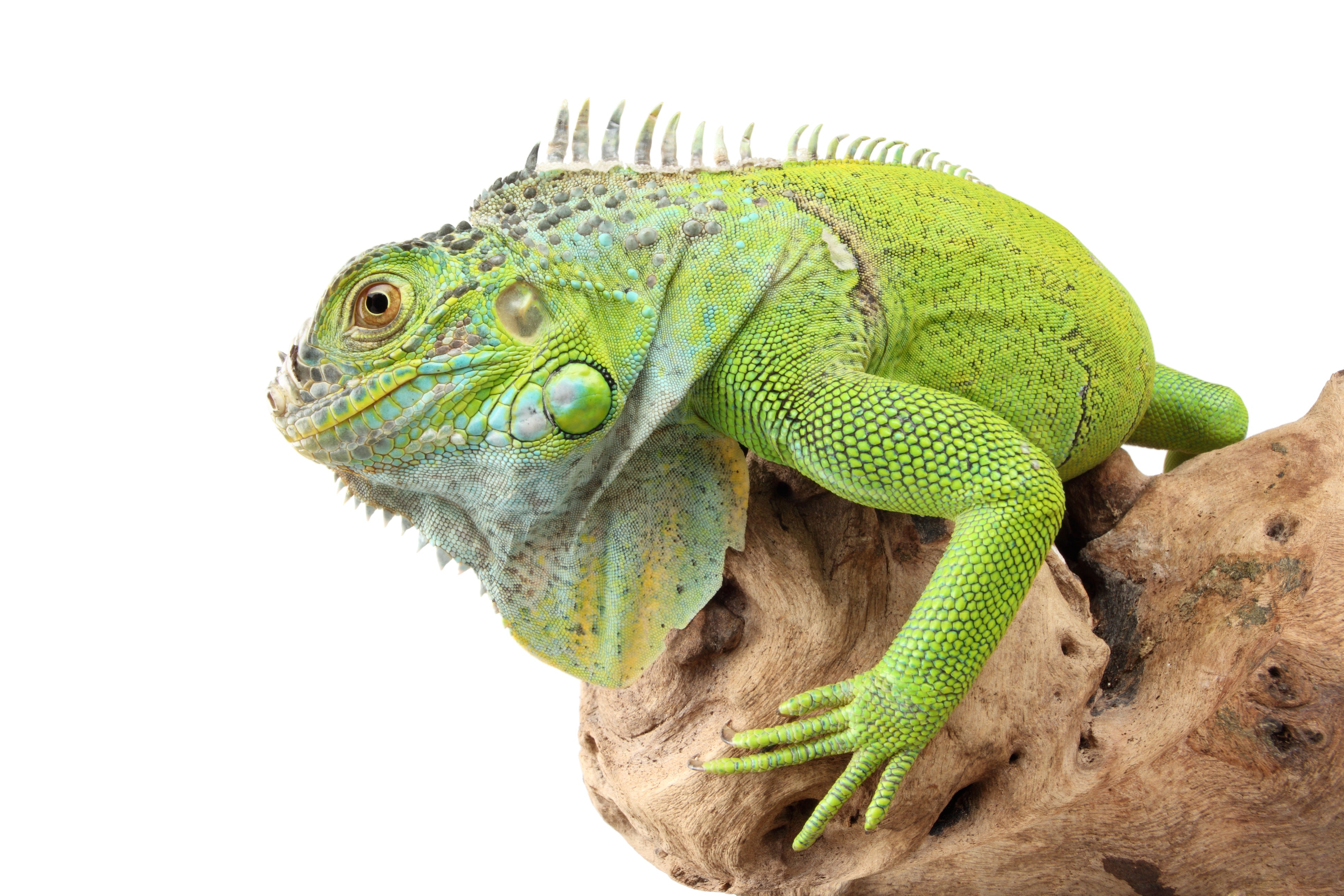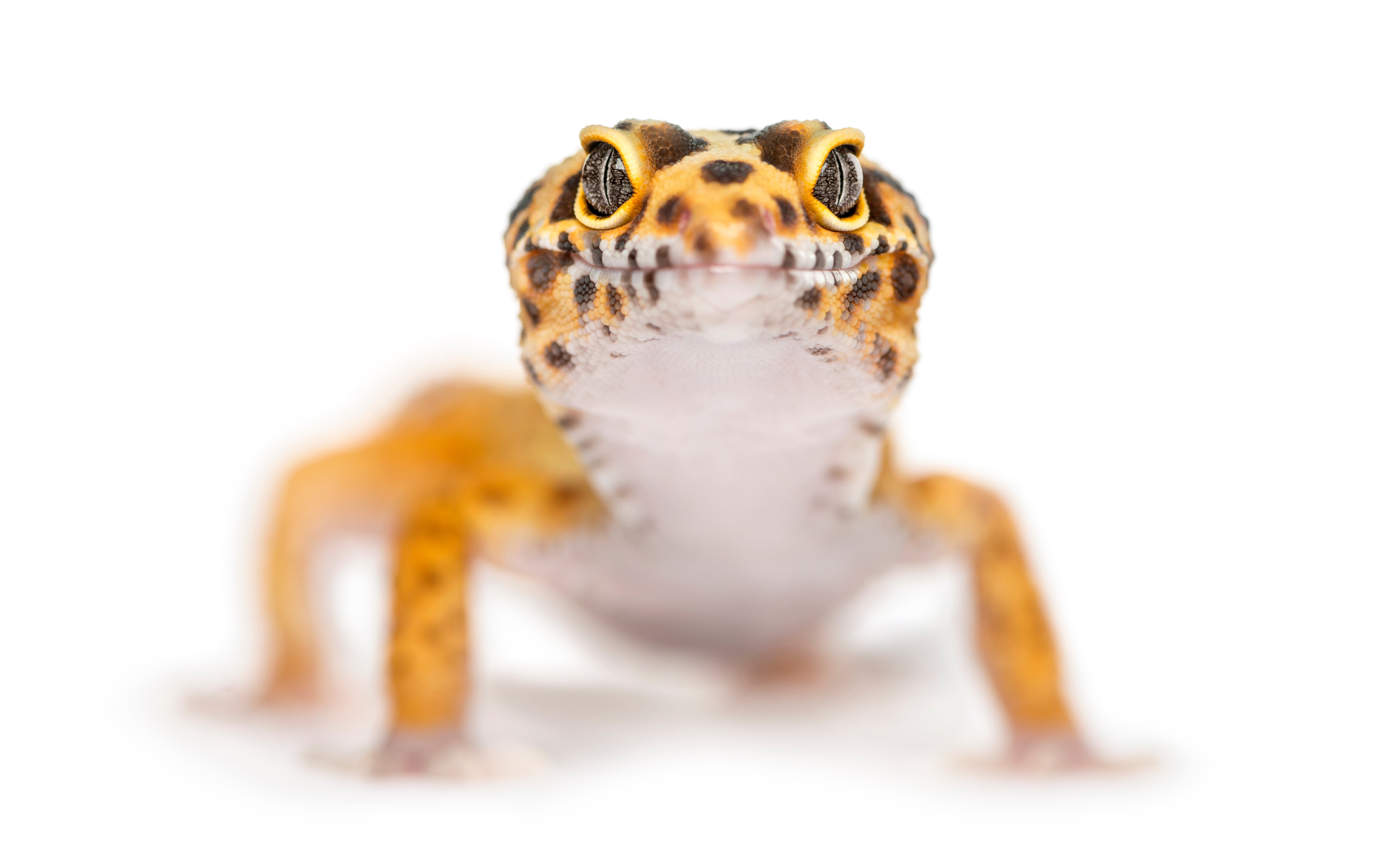Jackson’s Chameleons (Trioceros jacksonii) are moderate-sized, diurnal, arboreal lizards native to the mountains of Kenya and Tanzania. Adults grow to 7-14” long and can live up to 9 years with good care, with males living longer than females.
Jackson’s chameleons are generally bright green with a darker pattern, but exact color and pattern depends on the subspecies, sex, local temperature, and the individual’s mood. Although chameleons’ color-changing abilities are usually thought of as a camouflage mechanism, but it’s actually used for communication with other members of their species. Males have three horns, while females generally have fewer — and sometimes none at all.
Although Jackson’s chameleons are easier to keep than they were when first introduced into the hobby, they have unique needs that make them challenging to keep.
How much space do Jackson’s chameleons need?
A single Jackson’s chameleon should be housed in no smaller than a 24”L x 24”W x 48”H enclosure. Of course, larger is better! Despite common claims that they “require” a full-mesh enclosure, it is actually better to use an enclosure with 2-3 solid sides, which can be done by covering the sides and back of a mesh enclosure with thin PVC panels. This helps retain humidity and give the chameleon a better sense of security in its enclosure.
Cohabitation (keeping multiple chameleons in the same enclosure) is not recommended.
Do Jackson’s chameleons need UVB?
Yes!
UVB lighting is required for Jackson’s chameleons to stay healthy. Aside from helping provide a day/night cycle and providing an infinite supply of vitamin D, UVB is also good for the lizard’s overall health. Here are the best UVB bulbs for Jackson's chameleons housed in a 24”L x 24”W x 48”H enclosure:
The basking branch should be positioned so the chameleon’s back is 6” below the top of the enclosure. The UVB bulb should be housed in a reflective T5 HO fixture like the Arcadia ProT5 Fixture. Make sure that the fixture your UVB bulb is housed in does not have a clear plastic bulb cover, as plastic and glass block UVB.
Jackson’s chameleons are diurnal, which means that they are most active during the day. This means that it’s beneficial to provide an additional daylight-spectrum lamp to make sure the enclosure is brightly illuminated. The 22” Arcadia LED Bar or similar is a good choice for this.
Provide 12 hours of light each day to simulate daylight.
What basking temperatures do Jackson’s chameleons need?
Jackson’s chameleons need a basking area temperature of 85°F and a general air temperature of 68-75°F. Nighttime temperatures should drop down to 50-65°F. Temperatures should be measured with digital probe thermometers, with probes placed on the basking spot and the floor on the cool side.
The basking surface itself should be a sturdy wood branch or vine placed near the top per the specifications listed previously.
Provide heat for your chameleon with a halogen heat lamp placed on one side of the enclosure. For best results, elevate the lamp above the top of the enclosure with the Exo Terra Light Bracket. Do not use ceramic heat emitters (CHEs), heat mats, red bulbs, or blue bulbs, as these are not as effective.
The heat lamp should be turned off at night.
What humidity levels do Jackson’s chameleons need?
Jackson’s chameleons do best with low humidity (30-50%) during the day and high humidity (75-100%) at night. Mist 2x/day with a pressure sprayer first thing in the morning and in the evening, then run a humidifier on and off over the course of the night.
Reptile humidifiers and foggers should only be used with distilled water and require frequent disinfecting to keep your reptile from getting sick.
Humidity should be measured with a digital probe hygrometer with the probe in the middle of the terrarium. Humidity levels that are consistently too high or low will make your chameleon sick!
What substrate is good for Jackson’s chameleons?
Because Jackson’s chameleons are strictly arboreal, and because of all the water that goes through their enclosures every day, it’s best not to use a substrate with this species. Instead, use a solid bottom with a drain into a large bucket. This will require some DIY, but is well worth it in the end.
What décor can you use in a Jackson’s chameleon terrarium?
A bare, minimalistic enclosure leads to a stressed chameleon — and a stressed chameleon is a chameleon that quickly gets sick. In order to create a functional setup for your Jackson’s chameleon, you will need plenty of thin branches, vines, and plants (preferably live). Arrange the foliage to create hiding places for the chameleon to use as needed, with an open area under the heat lamp.
What do Jackson’s chameleons eat?
Jackson’s chameleons are strictly insectivorous, which means that they need to eat a variety of insects to get the nutrition that they need. How much they need to eat varies depending on age:
- Babies (1-3 months) — As much as they can eat, 2x/day
- Juveniles (3-6 months) — 10-12 small crickets/day
- Subadults (6-12 months) — 8-10 medium crickets/day
- Adults (over 1 year) — 6-8 medium or large crickets every other day
Feeder insect options: crickets, discoid roaches, dubia roaches, banana roaches, red runner roaches, black soldier flies, hornworms, silkworms
Remember, variety is key to great nutrition!
Supplements
You will also need calcium and vitamin supplements to prevent your chameleon from developing a deficiency. Follow this schedule for supplementing a Jackson’s chameleon:
- Every feeding: Arcadia EarthPro A
- Once per month: Repashy Calcium Plus LoD
It is also important to make sure that all feeders are well hydrated and gutloaded!
Do Jackson’s chameleons like to be handled?
Truthfully, few reptiles actually “like” to be handled. When it comes to Jackson’s chameleons, they’re generally “hands-off” pets that are better to simply admire than to try to play with. The key to building a trusting relationship with your pet is to provide as many positive interactions as possible. Offering food from feeding tweezers is a good way to bond.
*This care sheet contains only very basic information. Although it’s a good introduction, please do further research with high-quality sources to obtain additional information on caring for this species. We recommend starting with these sources:




Leave a comment
This site is protected by hCaptcha and the hCaptcha Privacy Policy and Terms of Service apply.